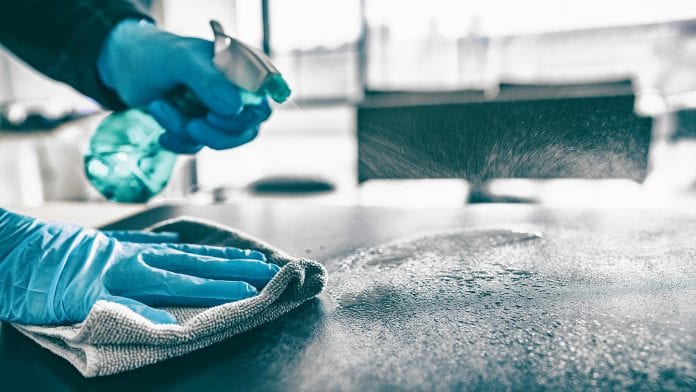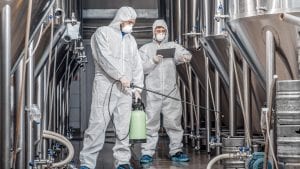
Dr David McCanna and Jacob Sivak talk to HEQ about how UVC can change the face of disinfection and its environmental impact.
Following the outbreak of COVID-19 the disinfectant industry has seen a boom. Between 2019 and 2020, its value grew by $220 million as businesses and consumers increased their use of cleaning products in an effort to tackle the outbreak.1 However, the long term environmental effects of the chemical elements used in disinfectants may be equally costly, with novel research indicating that UVC technology may potentially be able to leverage those dangers.
Benzalkonium chloride (BAK) is the primary active ingredient in a plethora of disinfection and cleaning products sold by household-name brands including Zoflora and Dettol. It is also found in industrial products used in hospitals and the food industry. BAK is highly effective against a variety of bacteria and viruses, ranging from salmonella to E. coli to coronaviruses, chemically breaking down the membrane of the bacterial cell, killing it and rendering it harmless to humans. Whilst BAK is highly effective, it poses a hidden threat to both humans and the natural world as high levels of the chemical are toxic and its presence in our waterways can cause irreparable damage to marine environments. In response to this toxicity BAK must be used in small, non-harmful doses and its contact with food products closely monitored, with strict limits being established as to the amount of trace chemical that can be present in consumables.
A team at the University of Waterloo, led by Dr Manlong Xu, has been researching the dangers of BAK, especially in terms of its impact upon eye health. Their revolutionary findings have found that the chemical risk of BAK can be neutralised using UVC technology.2 This will allow BAK to be used in higher concentrations without causing environmental harm, ensuring commercial and industry spaces are clean and safe whilst protecting both humans and our marine ecosystems. Dr David McCanna and Dr Jacob Sivak from the University of Waterloo spoke to HEQ about the findings of their research and its potential impact.
What was the nature of the initial study that led to your discovery?
Dr Jacob Sivak: “This study grew from a long-standing effort to develop in vitro alternatives to using live animals to test the toxicity of chemicals on the eye. Our aim was to develop cell culture techniques that allow testers and researchers to perform lab tests without the need for animal studies therefore working towards cruelty free testing modes. The basis of our research was to use human corneal cells to examine what happens when you expose human tissue to the chemical benzalkonium chloride (BAK) which is used extensively in common cleaning products, especially during the pandemic. Once the chemical was applied, we looked at how we could manage the residue as while it is effective in destroying bacteria and viruses, it is also toxic to humans and animals.”

What are the key health and environmental risks associated with benzalkonium chloride (BAK)?
Dr David McCanna: “Benzalkonium chloride is toxic to humans and the environment, as well as, aquatic organisms. Despite this, BAK is used in hospitals and food processing plants, even in homes, due to its effective disinfectant properties. It is a billion-dollar industry with the chemical being produced en masse globally. An article published in 2019 explored the toxicity of BAK, and its effect on humans and marine life, finding it to be highly toxic, leading to great environmental concern.3 The European Commission, who are involved in the regulation of benzalkonium chloride recently adjusted the rules, changing the maximum residual levels of BAK on consumables from 0.5 milligrammes per kilogramme to 0.1 milligrammes per kilogramme, showing that they recognise the risks associated with the chemical. On the other hand, it is highly efficient, it is effective against viruses, bacteria moulds, fungi, and protozoa. Although it is toxic it is not necessarily carcinogenic, but it is proven to cause contact dermatitis, eye irritation and skin irritation so its risks should not be overlooked.
The problem is BAK is currently being used at a level which is toxic to the environment and poses a risk to human health. However, through the discovery of the neutralising effect of UVC light, BAK can be used in even greater concentrations efficiently tackling microorganisms while having less impact on the environment. By neutralising the chemical’s toxicity, it would provide safer methods of disinfection in hospitals and households and would allow food processing plants to tackle issues such as salmonella whilst not breaching the regulations of the EU Commission.”
What are the mechanisms by which UVC radiation could neutralise these risks? Does UVC radiation have any effect on the efficacy of BAK disinfectants?
Dr David McCanna: “UVC will not disrupt the initial cleaning properties of BAK disinfectants because it is used after the disinfection. Firstly, you would disinfect with BAK, and then after the disinfection you would bring in the UVC which will neutralise the BAK. The great advantage of this method is that UVC is also highly effective at killing microorganisms. So, both parts of the method kill organisms just using two different mechanisms -BAK breaks down cell membranes, whereas UVC mutates the DNA of the microorganisms and by having two different mechanisms of killing the microorganisms, you have an enormous effect on reducing the microbial load of viable microorganisms.”

What are some potential real-world applications for dual BAK-UVC disinfection?
Dr David McCanna: “The dual process would be highly beneficial for hospitals, especially in the prevention of nosocomial infections. The dual process allows for greater efficacy of disinfection, eliminating the chance for microbial growth on areas that may be missed accidentally in the disinfection process due to the greater reach of UVC light. Following recent issues with outbreaks of foodborne diseases in American and Canadian meatpacking facilities, I believe they would also benefit from dual disinfection as it would allow them to use a stronger disinfectant without compromising their product and therefore ensuring it is safe for consumption.”
Is there a necessity for additional or more targeted research in this field?
Dr David McCanna: “There is absolutely a need for additional research into dual disinfection, especially given the current outbreak of COVID-19 and the commonality of outbreaks of microorganisms and foodborne illnesses in food processing plants which are affecting the supply of food throughout North America. Furthermore, aquatic animals are increasingly affected by the amount of disinfection that is required to combat all of these contagions. That is why the UVC method is so innovative, you increase the disinfection efficacy of your procedures whilst reducing the amount of toxicity of those disinfecting agents, so that they do not harm human health or the environment.”
References
- https://www.ibisworld.com/industry-statistics/market-size/disinfectant-manufacturing-united-states/
- https://www.tandfonline.com/doi/full/10.1080/15569527.2021.1902339
- https://journals.asm.org/doi/full/10.1128/AEM.00377-19
Dr Manlong Xu
Clinical Research Fellow
Dr David McCanna
Research Assistant Professor
Dr Jacob Sivak
Distinguished Professor Emeritus
School of Optometry & Vision Science
https://uwaterloo.ca/
This work was supported by the Natural Sciences and Engineering Research Council of Canada under Grant RGPIN 9747–2010.
This article is from issue 18 of Health Europa. Click here to get your free subscription today.










